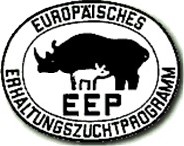 |
European Captive Breeding Programme Zoos as refuges |
 |
| Today,
many zoos have joined captive breeding programmes for animals which some
years ago would not even have been considered for these programmes, such
as Indian rhinoceroses, gorillas and Emperor penguins. In order to breed
strong and healthy, self-preserving animals, zoos have introduced breeding
record books. The first one of these breeding record books was presented in 1923 for wisents. Meanwhile there are far more than 100 of these books. In Europe, the European Captive Breeding Programme (EEP) was started. By now 1983 more than 300 zoos have joined the Programme. Zoo animals can be regarded as 'nature's reserve'. Today, there are quite a few animal species that owe their existence to captive breeding programmes. During the 1980s, nature protection agencies as well as the International Union for Conservation of Nature (INCN) understood that zoo captive breeding programmes can contribute to species preservation. In 1987, the INCN clearly expressed this insight in its documentation on captive breeding programmes. |
It said: "Biotope protection alone is not enough if our common goal as stated in the World Nature Conservation Strategy, i.e. the preservation of bio-diversity, is to be reached." The breeding of self-preserving specimens and other support programmes are necessary to prevent the disappearance of endangered species in particular of those whose habitats and living conditions have to a large extent been destroyed, or reduced. Captive breeding programmes must be started before species have been reduced to crucially small numbers of individuals. These programmes must be scientifically co-ordinated and follow the principles of natural sciences and biology so that strong animal populations can be sustained or re-introduced. The publication and visibility of successful breeding programmes is vital for these projects. Annually, about 100 million people visit European zoos. Worldwide, the number of visitors exceeds 600 million. At any zoo, visitors can become acquainted with the amazing variety of life on Earth. Many visitors want to become involved with flora and fauna and natural habitat protection programmes. No other institution, no other means of communication can similarly impress and inspire people. Therefore, zoological captive breeding programmes' contributions are twofold: species protection and nature conservation associations. | |
